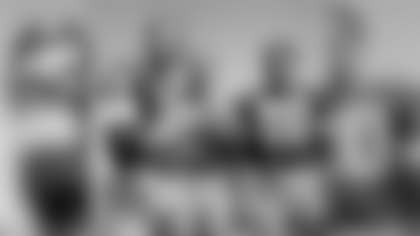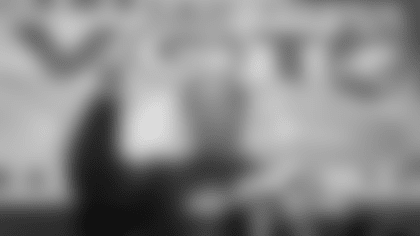Gregory from Palmyra, PA
How would you rate the pro careers of Donny Anderson and Mike McCoy?
Interesting that you picked those two players for this reason: If you go back to 1960, Vince Lombardi's first draft, the expectations for those two players were maybe greater than for any Packers pick other than Tony Mandarich in the years since. Anderson was the seventh choice in the 14-team, 1965 NFL draft, but one of only two futures ever taken in the first round, according to published reports at the time. The other was Dick Bass, a fullback taken second overall in 1959 by the Los Angeles Rams. McCoy was the second overall choice in 1970. In the 1950s, the Packers exercised 10 top-five picks. In the 62 drafts since then, they have had six and only two among the first three selections: McCoy and then Mandarich in 1989. What's more, Anderson signed a contract that was believed to be the richest in pro football history at the time and the pick used on McCoy cost the Packers three veterans from their Super Bowl teams: Lee Roy Caffey, Bob Jeter and Elijah Pitts. Obviously, Anderson and McCoy were in rare company as rookies and over the rest of their careers in Green Bay.
First, as background, players designated as "futures" in the NFL drafts held prior to the NFL-AFL merger were part of the original class of each draft's eligible players, but also had a year of football eligibility remaining. Thus, they could be drafted, but they couldn't sign with and play for an NFL team until their college eligibility expired. In Anderson's case, he had enrolled at Texas Tech with the June 1965 graduating class, but was eligible to play another year of college ball in the fall of 1965. When the AFL was formed in 1960, it chose to hold what it called a "redshirt" draft as a supplement to its regular draft. Thus, before the first common draft in March 1967 there was a fierce battle over what to do with "futures" or "redshirts." The most vocal proponent for including them in the regular draft was Vince Lombardi. Once he started winning, Lombardi started stockpiling draft picks through trades of players he considered expendable, many of them highly touted rookies that he planned to release in his final cuts. As a result, heading into the 1967 draft, the Packers owned 24 choices in what would be a 17-round draft, including 10 in the first five rounds. That was more than any team in the league other than New Orleans, an expansion franchise which had been awarded at least one extra choice in each round. Keep in mind, this debate over what to do with "futures" took place in the two months following the Packers' victory in Super Bowl I. Overall, the Packers owned the ninth pick in the first common draft from a trade with Pittsburgh, where Lombardi gave up lineman Lloyd Voss, his No. 1 choice in 1964 who had yet to become a starter, and tight end Tony Jeter, a third-round selection in 1966 who wasn't going to make the team. In turn, there was speculation that with all his draft picks, Lombardi might take a future in the first round: Notre Dame defensive tackle Kevin Hardy. The battle over this issue was still raging a month before the draft and when the league went against Lombardi's wishes he was furious. Commissioner Pete Rozelle announced less than a week before the draft that no player with college eligibility remaining could be drafted until five seasons of football had elapsed since he first entered college.
Back to Anderson and McCoy. Anderson became the starting halfback during his second season and might have been the most productive player in the Ice Bowl. His numbers in that game don't jump off the stat sheet, but considering the NFL still recognizes it as the coldest game in history, his contribution should be viewed in that context. Anderson rushed for a team-high 35 yards on a game-high 18 attempts, caught four passes for 44 yards including three for 27 on the final drive, and punted eight times for a 28.8-yard average. In all, Anderson handled the ball 30 times. That was 13 more times than anyone else on the field other than the quarterbacks. In the locker room afterward, Lombardi walked up to Anderson, patted him on the back of the neck and said, "You became a man today."
Taking into account Anderson's combined rushing and receiving stats, plus his punting, he finished with good numbers in 1968, 1970 and 1971. Also, he never missed a game in six seasons with the Packers. But after one year under Dan Devine he wanted out and was traded for MacArthur Lane before the 1972 season. It was a trade that worked out well for the Packers, but what we'll never know is if Anderson would have had a better career in Green Bay if he had played more than two seasons for Lombardi. Lombardi's signature play was the power sweep, Red Right 49, the halfback running to the right side. As a lefthander, Anderson felt more comfortable running left and throwing the option pass going to the left. He also wasn't as big and as good a blocker as Paul Hornung, the player he replaced, which was a disadvantage for Lombardi's weak-side runs with the fullback. While that didn't seem to be of great concern to Lombardi, he did entertain thoughts of moving Anderson to flanker. Back then, most backs played every snap from just a few two-back formations, but one wonders if Lombardi would have found a way to better maximize Anderson's versatility. After Super Bowl II, Lombardi talked about going to a three-back set in the future with Travis Williams, Anderson and Jim Grabowski on the field at the same time.
As for McCoy, he started for the Packers at defensive tackle for seven years and missed only four games with injuries. Again, like Anderson, he was considered a solid player with some valuable intangibles. He was big for his time, at 6-foot-5 and roughly 280 pounds. He was a high-effort player. And he was credited with being the Packers' unofficial sack leader in 1973 with six and co-leader in 1976 with 8½. But he never made all-pro, never was selected to a Pro Bowl and never had the impact that was expected of him as a pass rusher. Three games into the 1977 preseason, then third-year head coach Bart Starr moved McCoy to offensive guard. The experiment lasted two weeks before McCoy was moved back to defense and then traded to Oakland in a deal that netted a first-round draft pick used on linebacker John Anderson.
What was interesting about the McCoy choice was that after future Pro Football Hall of Famer Alan Page was drafted 15th by Minnesota in 1967, there was a run of other Notre Dame defensive linemen who were highly touted prospects, but turned out to be busts. The list included Kevin Hardy, eighth overall choice in 1968; Walt Patulski, the first overall, and Mike Kadish, the 25th pick, in 1972; and Steve Niehaus, second overall choice in 1976. McCoy was probably the best of that batch, but NFL teams started red-flagging Notre Dame defensive linemen for that reason. "We're scared to death of them," Dick Corrick, Starr's personnel director, told me in the early 1980s after the verdicts had been handed down on the careers of those aforementioned players.
Mike from Mill Spring, NC
There has been speculation that Vince Lombardi considered trading Bart Starr for Don Meredith. If true, why didn't Lombardi complete the trade? And what would the Packers' offense have been like with Meredith under center? Starr was considered to be one of the best field generals of his time.
My guess is you've maybe read where Jim Kensil, who was commissioner Pete Rozelle's top aide for more than 15 years, related a story about a dinner he had with Lombardi in early 1961 following Meredith's rookie year. Kensil said Lombardi told him that night he offered Dallas general manager Tex Schramm any two players on his team in exchange for Meredith.
But that wasn't the only time a trade was discussed. For our book on the definitive history of the Packers, Jack Koeppler, a member of the team's board of directors and one of Lombardi's close friends in Green Bay, told me in an interview that maybe after 1963 or the 1964 season – he couldn't remember the exact year – he was playing golf with Lombardi when someone from the pro shop at their country club outside Green Bay tracked them down on the course to tell Lombardi he needed to return a phone call to Schramm. Obviously, this was before cell phones. Koeppler said it was the only time that Lombardi left the course in their many years of playing together to take a phone call. When Lombardi returned to resume his golf game, he told Koeppler that Schramm had just turned down a straight-up deal: Starr for Meredith.
How would history have changed had the trade been made? Well, we know this. The Packers couldn't have done any better unless the deal was rejected before their disappointing 1964 season. Thereafter, they won three straight titles from 1965 to 1967 with Starr winning MVP honors in the first two Super Bowls. It was known within league circles that Lombardi had fixated on Meredith's raw talent. But Starr outplayed Meredith in the 1966 and 1967 NFL championship games. That said, those were close games and Lombardi had great confidence in his ability to get maximum production out of his players.
Ryan from Elmhurst, IL
Zeke Bratkowski played a crucial role in many of the Packers' 1960 championships, although he was Bart Starr's backup. Who were some of the other unsung heroes who played important, non-starring roles?
No doubt, Bratkowski would lead the list during the Lombardi years. He was nicknamed "Super Sub" for good reason. During the Packers' three-year reign as NFL champions from 1965 to 1967, they were 8-1 in games, including postseason, where Bratkowski either started in place of Starr or replaced him with the score tied or the Packers trailing by no more than seven points.
The next player who comes to mind was Tom Moore, who started seven games for an injured Hornung when the Packers won the NFL title in 1962 and then started the next season when Hornung was suspended. In 1963, Moore rushed for 658 yards and averaged five yards per carry. Another player would be Norm Masters, although he was essentially a starting tackle under Lombardi for six years through 1964. Masters either shared the left tackle position with Bob Skoronski or started at right tackle so Forrest Gregg could fill in at guard when Jerry Kramer missed 18 games in 1961 and '64 due to injuries.
As for others, they were mostly starters during Lombardi's first five, six seasons. Emlen Tunnell started at safety on Lombardi's first two teams and might have had as much to do with the Packers' resurgence as anyone but Lombardi. Interestingly, Lombardi all but begged Bobby Dillon to change his mind about retirement in 1959 and even secretly rescinded his fines to get him to play, but then started Tunnell and John Symank at safety late in the year. Tom Bettis was another veteran who helped turn what had been the worst or second-worst defense in the league for three straight years into the third best in 1959. He started at middle linebacker ahead of Ray Nitschke for all of 1959 and most of the 1960 season. Then in 1961 when Nitschke was called into service and could only get weekend passes to play in the games, Bettis returned to the lineup and played as much as Nitschke, if not more. Paul Hornung and Boyd Dowler played on weekend passes, too, but they started. Obviously, Lombardi felt more comfortable playing them even if they hadn't practiced than he did with Nitschke. I think I've asked this trivia question before: Who was the Packers' middle linebacker who got carried off the field by fans after the 37-0, 1961 championship game in Green Bay? Bettis is the answer. Gary Knafelc started at tight end in 1959 and '60 ahead of Ron Kramer, who then emerged as maybe the best tight end in the league in 1961 and '62.
I wouldn't necessarily call them unsung players because they were starters and, in many cases, standouts on Lombardi's first two championship teams, but they haven't been remembered as fondly as the starters on Lombardi's last three title teams. Here are some of the names. Hank Gremminger started five years at cornerback and safety, and also was the defensive captain between Bill Forester and Willie Davis. Forester was the defensive captain and a four-time Pro Bowl pick at linebacker on Lombardi's first five teams. Dan Currie started at left linebacker for six years under Lombardi and was an all-pro player. Until he got hurt on a blindside block late in 1962, he was considered the better linebacker of the two drafted in the first three rounds in 1958. Currie was the No. 1 pick that year; Nitschke, a third-rounder. Jesse Whittenton started at cornerback for six years under Lombardi and was considered one of the best in the league. Dave Hanner had played for seven years before Lombardi arrived, but he was another major, less decorated contributor to the defense's improvement under Lombardi and Phil Bengtson.
On the 1965-67 championship teams, Tom Brown was a three-year starter at safety. Doug Hart started at cornerback ahead of Bob Jeter on the 1965 team. That also was the year Bill Anderson took playing time away from Marv Fleming at tight end. Another trivia question: Who was the Packers' leading receiver in the 1965 sudden-death playoff victory over the Colts? Bill Anderson with eight catches for 78 yards. Bob Long averaged 23.4 yards per catch as a backup receiver. Elijah Pitts was Hornung's original replacement at halfback and a key to the Packers winning Super Bowl I. Of course, Jim Taylor's replacements, Chuck Mercein and Ben Wilson, were truly unsung heroes of the 1967 postseason. Mercein is best remembered for his contribution on the final drive in the Ice Bowl, whereas Wilson was the leading rusher in Super Bowl II.















